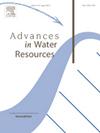多观测资料下水体超扩散污染源识别的条件后向分数导数模型
IF 4.2
2区 环境科学与生态学
Q1 WATER RESOURCES
引用次数: 0
摘要
已经开发了超扩散的落后模型来确定污染源位置,但它们仅限于单一观察,而忽略了现场测量的浓度。为了克服这些限制,本研究导出了空间分数平流-色散方程的伴随方程,并结合了来自多个观测数据的测量浓度。后向概率,如后向位置概率密度函数(PDF),描述了采样前固定时间可能的源位置,为源识别提供了一种全面的建模方法。通过贝叶斯定理,将每个观测值的单独PDF及其相应浓度组合成一个联合PDF,与之前的单个PDF相比,增强了信息和可靠性。现场应用表明,改进后的模型提高了反演PDF识别天然河流和含水层点源的精度(PDF峰值位置更接近实际源)和精度(方差更小)。模型的性能受观测计数和测量误差的影响,由于源质量的不确定性,可能在反向位置的PDF中出现双峰。未来的改进,如纳入反向旅行时间分析和扩展应用于活性污染物,可以进一步提高本研究中开发的条件向后分数导数模型的效用。本文章由计算机程序翻译,如有差异,请以英文原文为准。
A conditioned backward fractional-derivative model for identifying super-diffusive pollutant source in aquatic systems with multiple observation data
Backward models for super-diffusion have been developed to identify pollutant source locations, but they are limited to a single observation and disregard field-measured concentrations. To overcome these limitations, this study derives the adjoint of the space-fractional advection–dispersion equation, incorporating measured concentrations from multiple observation data. Backward probabilities, such as the backward location probability density function (PDF), describe the likely source location(s) at a fixed time before sampling, offering a comprehensive modeling approach for source identification. By applying Bayes’ theorem, the individual PDFs from each observation and its corresponding concentration are combined into a joint PDF, enhancing both the information and reliability compared to the previous single PDF. Field applications show that the improved model enhances accuracy (with PDF peak locations closer to the actual source) and precision (with reduced variance) of backward PDFs for identifying point sources in a natural river and aquifer. The model’s performance is affected by observation count and measurement errors, with double peaks in the backward location PDF possible due to source mass uncertainty. Future refinements, such as incorporating backward travel time analysis and extending applications to reactive pollutants, could further enhance the utility of the conditioned backward fractional-derivative model developed in this study.
求助全文
通过发布文献求助,成功后即可免费获取论文全文。
去求助
来源期刊

Advances in Water Resources
环境科学-水资源
CiteScore
9.40
自引率
6.40%
发文量
171
审稿时长
36 days
期刊介绍:
Advances in Water Resources provides a forum for the presentation of fundamental scientific advances in the understanding of water resources systems. The scope of Advances in Water Resources includes any combination of theoretical, computational, and experimental approaches used to advance fundamental understanding of surface or subsurface water resources systems or the interaction of these systems with the atmosphere, geosphere, biosphere, and human societies. Manuscripts involving case studies that do not attempt to reach broader conclusions, research on engineering design, applied hydraulics, or water quality and treatment, as well as applications of existing knowledge that do not advance fundamental understanding of hydrological processes, are not appropriate for Advances in Water Resources.
Examples of appropriate topical areas that will be considered include the following:
• Surface and subsurface hydrology
• Hydrometeorology
• Environmental fluid dynamics
• Ecohydrology and ecohydrodynamics
• Multiphase transport phenomena in porous media
• Fluid flow and species transport and reaction processes
 求助内容:
求助内容: 应助结果提醒方式:
应助结果提醒方式:


